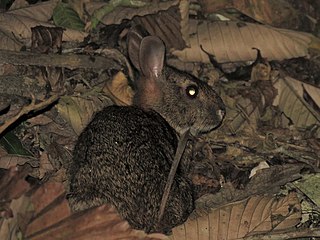
Leporidae is the family of rabbits and hares, containing over 70 species of extant mammals in all. The Latin word Leporidae means "those that resemble lepus" (hare). Together with the pikas, the Leporidae constitute the mammalian order Lagomorpha. Leporidae differ from pikas in that they have short, furry tails and elongated ears and hind legs.

The desert cottontail, also known as Audubon's cottontail, is a New World cottontail rabbit, and a member of the family Leporidae. Unlike the European rabbit, they do not form social burrow systems, but compared with some other leporids, they are extremely tolerant of other individuals in their vicinity.

Desmodus is a genus of bats which—along with the genera Diaemus and Diphylla—are allied as the subfamily Desmodontinae, the carnivorous, blood-consuming vampire bats of the New World leaf-nosed bat family Phyllostomidae.

Cottontail rabbits are in the Sylvilagus genus, which is in the Leporidae family. They are found in the Americas. Most Sylvilagus species have stub tails with white undersides that show when they retreat, giving them their characteristic name. However, this feature is not present in all Sylvilagus, nor is it unique to the genus.

The brush rabbit, or western brush rabbit, or Californian brush rabbit, is a species of cottontail rabbit found in western coastal regions of North America, from the Columbia River in Oregon to the southern tip of the Baja California Peninsula. Its range extends as far east as the eastern sides of the Sierra Nevada and Cascade mountain ranges.

The eastern cottontail is a New World cottontail rabbit, a member of the family Leporidae. It is the most common rabbit species in North America.

The thick-billed parrots are stocky brilliant green Neotropical parrots with heavy black beaks of genus Rhynchopsitta of thick billed macaw-like parrots. The genus comprises two extant species, the thick-billed parrot and the maroon-fronted parrot, as well as an extinct species from the Late Pleistocene in Mexico. The two extant taxa were formerly considered conspecific; they have become rare and are restricted to a few small areas in northern Mexico. The range of the thick-billed parrot formerly extended into the southwestern United States; attempts at reintroduction have been unsuccessful so far.

The commontapeti, also known as the Brazilian cottontail, forest cottontail, or (formerly) simply tapeti is a species of cottontail rabbit. It is small to medium-sized with a small, dark tail, short hind feet, and short ears. As traditionally defined, its range extends from southern Mexico to northern Argentina, but this includes several distinctive population that have since been split into separate species. Under this narrower definition, the true tapeti only occurs in the Atlantic Rainforest of coastal northeastern Brazil and it is classified as "Endangered" by the IUCN. The American Society of Mammalogists concurs, but also tentatively classifies several distinct populations that have not yet received proper species names into S. brasiliensis, and thus considers it to range from Venezuela south to Argentina.

The Omilteme cottontail is a cottontail rabbit found only in the state of Guerrero, Mexico in the mountain range of Sierra Madre del Sur. Belonging to the family Leporidae, it is one of fourteen species in the genus Sylvilagus, a genus restricted to the New World. The Omilteme cottontail is considered one of the most endangered rabbit species in the world and is only known and been described by very few specimens.

The Mexican cottontail is a species of cottontail rabbit in the family Leporidae. It is endemic to Mexico where its natural habitats are temperate forests, subtropical or tropical dry forests and pastureland.

The Tres Marias cottontail or Tres Marias rabbit is a species of mammal in the family Leporidae.

The mountain cottontail or Nuttall's cottontail is a species of mammal in the family Leporidae. It is found in Canada and the United States.

The Appalachian cottontail is a species of cottontail rabbit in the family Leporidae. It is a rare species found in the upland areas of the eastern United States.

The robust cottontail or Holzner's cottontail is a species of cottontail rabbit native to high-altitude regions of the southwestern United States and western Mexico.
Desmodus stocki, or Stock's vampire bat, is an extinct species of vampire bat native to Pleistocene, North America, inhabiting states like Arizona, West Virginia, and Florida, farther north than any living vampire bats. It weighed about 50% more than the common vampire bat, and was also more robust.

Coragyps occidentalis, the Pleistocene black vulture, is an extinct species of New World vulture that lived throughout North and South America during the Pleistocene. It was formerly thought to be the ancestor to the modern black vulture, but is now thought to have evolved from it; the modern black vulture is paraphyletic with respect to it.
The coastal tapeti, also known as the Rio de Janeiro dwarf cottontail or dwarf tapeti, is a species of cottontail rabbit native to Brazil. Known from only three specimens, captured in the late nineteenth century in the Paraíba Valley, it was for a long time considered to be a subspecies of the common tapeti. Slightly smaller than its close relative, analysis in 2017 confirmed that it is sufficiently distinct in both appearance and genetics to be considered a species in its own right. Due to destruction of its putative habitat in the densely populated Paraíba Valley, it is unclear whether or not the species still survives in the present day.

The Andean tapeti or Andean cottontail is a species of cottontail rabbit native to Colombia, Venezuela, Peru and Ecuador. It was previously considered a subspecies of the common tapeti. Living at high elevations in the treeless Páramo of the Andes, analysis in 2017 confirmed that it is sufficiently distinct in both appearance and genetics to be considered a species in its own right. Although widespread, it remains poorly known, as few studies have been conducted on its biology and habits as distinct from those of the tapeti

Chester Stock was an American paleontologist who specialized in the Pleistocene mammalian fauna of the Rancho La Brea tar pits. He served as a professor of geology at the California Institute of Technology, Pasadena.

The Central American tapeti or Gabbi's cottontail is a species of cottontail rabbit native to southern Mexico and much of Central America. It was previously considered a subspecies of the common tapeti but analysis in 2017 confirmed that it is sufficiently distinct in both appearance and genetics to be considered a species in its own right. The name Gabbi's cottontail comes from American paleontologist William More Gabb.

















